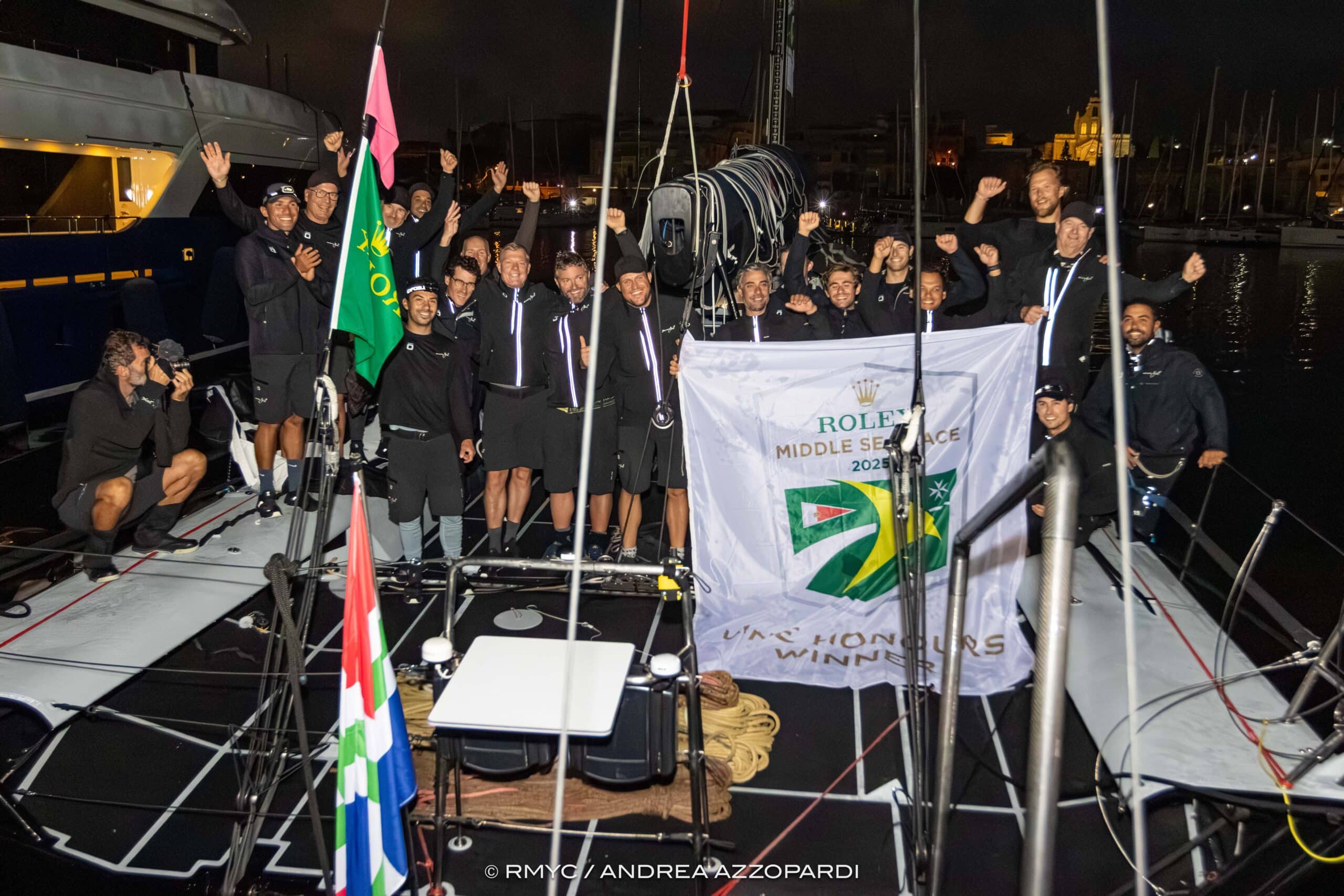
Today the Royal Malta Yacht Club brings an intense week to a close with the prize-giving ceremony of the 46th Rolex Middle Sea Race, an edition defined by fine tactical decisions, shifting winds and the confirmation that the overall trophy goes to Balthasar, the Mills 72 skippered by Louis Balcaen. Its corrected time left no room for reply from a fleet that fought until the very last leg, with Lampedusa becoming the decisive filter. Django Deer finished five minutes adrift on corrected time, a minimal gap after six hundred and six nautical miles that speaks of precision and consistency.
In line honours, Black Jack 100 delivered with authority, crossing the finish line early on the 21st. The Australian maxi arrived with a renewed project and an international crew assembled at speed. Its season had already shown clear signs, a record at Gotland Runt, line honours at the Fastnet and a record at the Palermo–Montecarlo. In Malta it confirmed both speed and reliability in a capricious Mediterranean, torrential rain on the first night, calms north of Sicily, long transitions and a final leg in light airs towards the south. The forecast demanded composure and clean handling.
In the multihull division, Allegra led the fleet home and, barring surprises, secured the MOCRA title. For Adrian Keller and Paul Larsen the race carried unfinished business since 2018. The Swiss trimaran managed the calms off Stromboli with patience and shifted into high gear from Lampedusa, making an impeccable entry through Marsamxett Harbour and sending a clear message that the multihull class continues to gain competitive weight in this Mediterranean classic.
The IRC class results paint a clear picture. Balthasar leads IRC 1 and crowns the overall standings, Django Deer wins IRC 2 after a steady race among the leading pack, Chenapan IV takes IRC 3 following a prolonged duel with Artie III that was decided en route to Lampedusa when the French crew found a breath of wind and the Maltese could not respond. In IRC 4, Ton Ton Laferla sealed victory by just two minutes and twenty-five seconds over Nola, a razor-thin margin after a tense finish through the Comino Channel. Noisy Oyster takes IRC 5 with an emotional but effective reading of last night’s shutdown off Lampedusa. In IRC 6, Zephyr repeats its title, underlining the value of a crew that has sailed together for years, with a clear plan, timely adjustments and calm execution when the pace slows.
The local chapter brings two notable results. Artie III was the first Maltese boat home at 02:03 CEST, while Vivace, the Reflex 38 of Andrew Agius Delicata and Matthew Gabriele, closes as the top Maltese entry overall with an impressive eleventh place among a hundred IRC-rated yachts. Their story emphasises the essence of true offshore racing, trust, clear roles and a steady rhythm, even when it means sewing a sail at midnight or cooking while the boat rolls.

Balthasar’s triumph marks a point of maturity in Louis Balcaen’s sporting project. After several attempts in major classics, victory in Malta consolidates the Mills 72 as one of the most complete platforms on the offshore circuit. The crew, built around an experienced core with Bouwe Bekking on tactics and Pablo Arrarte overseeing manoeuvres, handled a tactically and meteorologically demanding race with precision. The decisive move came after Favignana, when the team chose to head down towards the Tunisian coast in search of wind, a risky decision that ultimately defined the race. In Balcaen’s words, it was “a race of patience and trust”, where every manoeuvre had to be executed without margin for error. Their win combines strategy, seamanship and the consistency that ultimately prevailed over a world-class field.
The double-handed division produced its own narrative. Libertine was the first two-handed boat to finish, while Lunatika, skippered by Guido Baroni and Alessandro Miglietti, secured victory on corrected time after waiting until the final morning for Mowgli of Portsmouth to reach the line. The Harris brothers completed the course aboard a 60-year-old sloop without an autopilot, steering by hand for the entire race, an image that fits perfectly with the spirit of the event where tradition and performance coexist on a course that rewards patience, coastal awareness and bold decision-making.
Beyond the trophies lies the human pulse of the race. Young crews such as JYS Jan gain experience and miles, while veterans like Bouwe Bekking highlight how the key move came from chasing pressure far to the west near Pantelleria. Tacticians and navigators agree that this race demands thinking ahead of the forecast and making decisions before the data fully align, every corner of the course can turn a gamble into either an advantage or a dead stop.
As evening fell, the Sacra Infermeria in Valletta provided a fitting stage for the closing ceremony. The 16th-century building, once a hospital built by the Knights of St John, overlooks the Grand Harbour and remains one of Malta’s most emblematic spaces. The event was attended by Maltese dignitaries including Prime Minister Robert Abela and the Italian Ambassador, Valentina Setta. Commodore Mark Napier of the Royal Malta Yacht Club congratulated all 117 participating crews and acknowledged the volunteers, organisers and sponsors, including Rolex, whose support has accompanied the race for nearly 25 years.
Accepting the trophy on behalf of Balthasar, Bouwe Bekking described the race as “one of the great ocean classics”, praising the Maltese organisation and the growing number of young sailors competing each year. His words captured the spirit of a race that continues to blend endurance, seamanship and fellowship. The 47th Rolex Middle Sea Race will begin on Saturday, 17 October 2026.